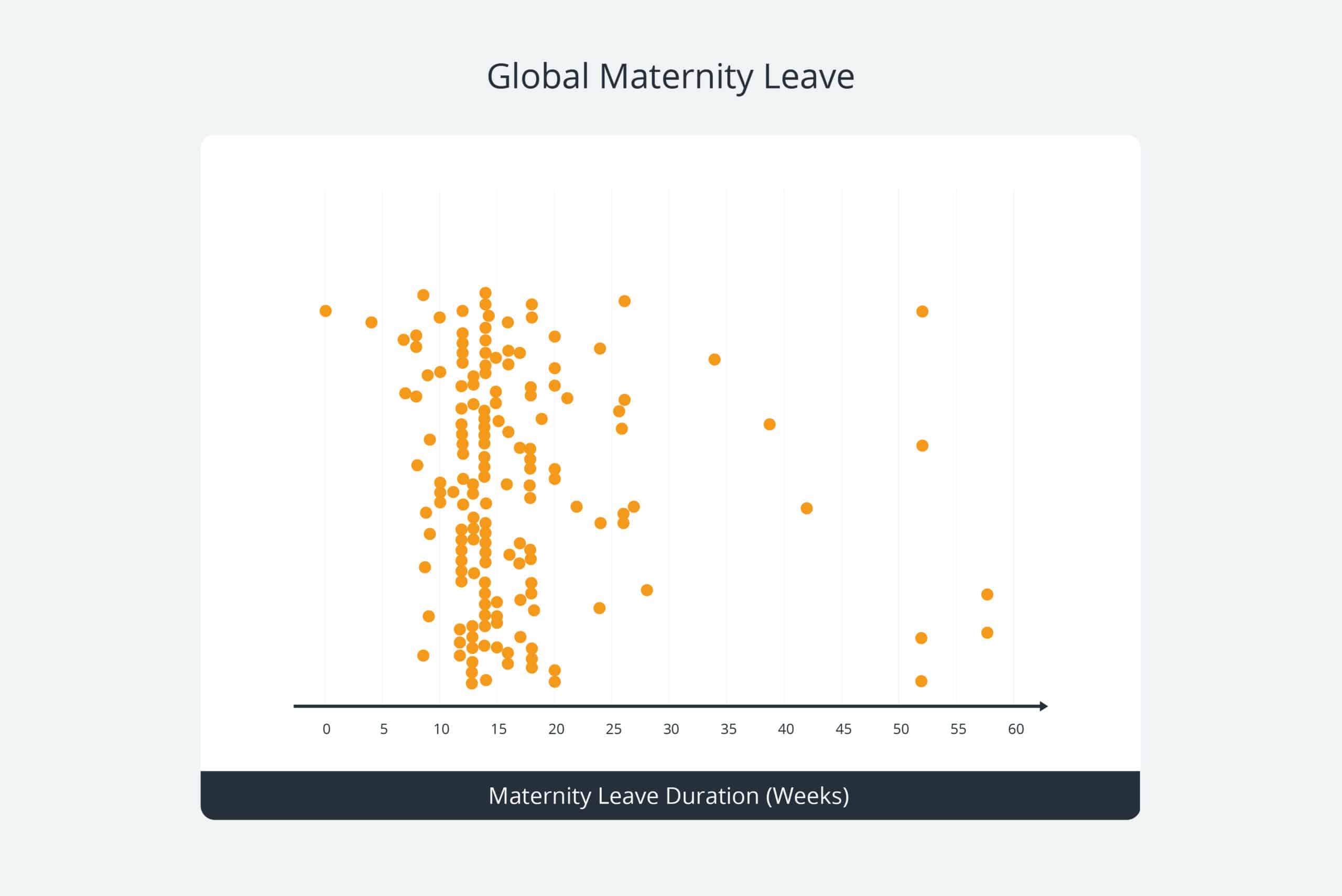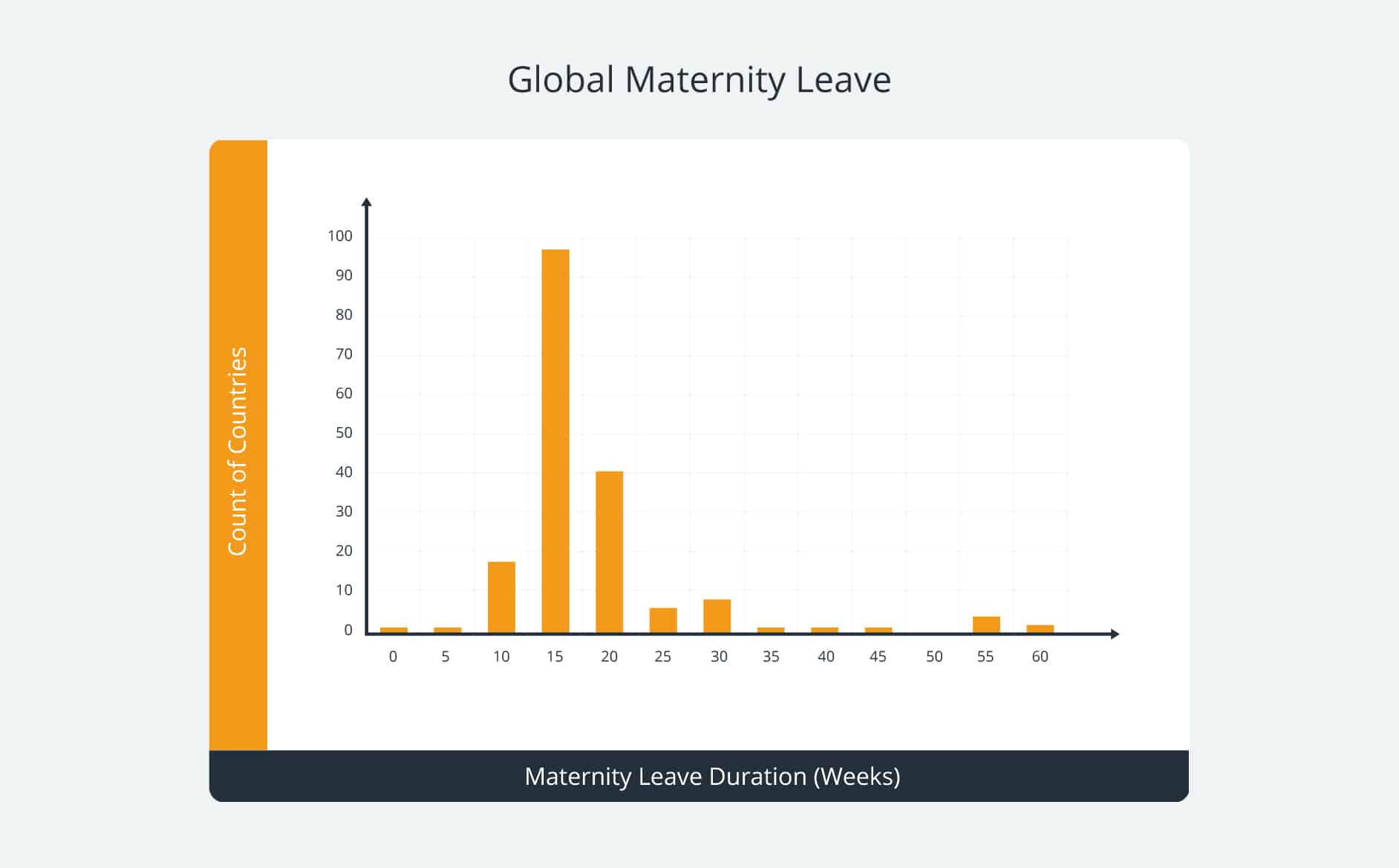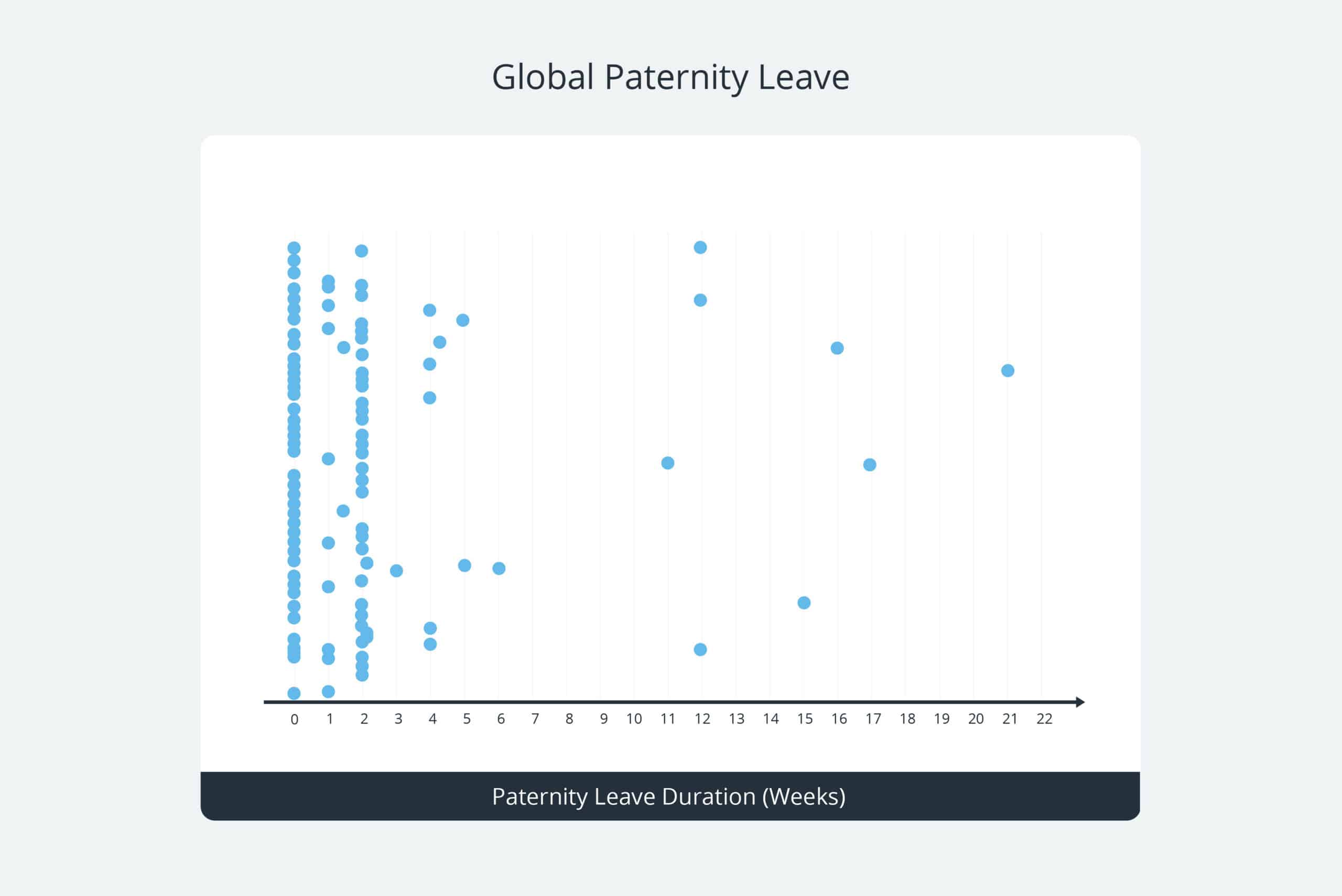Maternity & Paternity Leave Statistics Around the Globe
For new parents, knowing that their workplace is supporting them through pregnancy and into the first years of their child’s life is invaluable. Across the globe, different countries show a different story on the legal (maximum) requirements for maternity, paternity, and parental leave.
Remaining competitive in a global marketplace, as well as protecting the health and wellbeing of employees, remains a top priority of HR and hiring teams across the world. With the legal requirements varying in different regions, our guide will allow you to compare the data on the legal requirements for maternity and paternity pay across the globe.
Data last refreshed February 2024. Next full review is due February 2025.
An overview of global maternity leave


Every country (with available data) requires parents to receive paid maternity leave, except the United States (at a federal level). This data is based on the maximum requirement for companies to provide. Data isn’t included on self-employed maternity leave requirements, as this is less consistent across the globe.
Core statistics on global maternity leave
The global average for maternity leave duration is 16.3 weeks.
The majority of countries, 78.9%, offer between 10 and 20 weeks of maternity leave.
9.2% of countries offer 26 weeks (6 months) or more, whilst 4.3% of countries offer 39 weeks (9 months) or more.
Employee maternity compensation statistics
Globally, 55.1% of countries require employers to pay employees in full for the duration of their maternity leave.
21.6% of countries require employers to pay a set percentage, 95% or less, of an employee’s normal rate of pay throughout their leave duration, whilst 20% pay employees conditionally, based on leave duration, a set flat rate, an earnings cap, or individual annual income.
The remaining countries do not offer paid maternity leave.
Which country offers the longest maternity leave?
Bulgaria and Croatia both offer 58 weeks of maternity leave, which is 6 weeks higher than the next best group. 52 weeks is more standard across Europe, with countries like Montenegro, Albania and the UK offering this.
Maternity leave – Top 10
| Country | Weeks (Max) |
| Bulgaria | 58 |
| Croatia | 58 |
| Albania | 52 |
| Bosnia and Herzegovina | 52 |
| Montenegro | 52 |
| United Kingdom | 52 |
| Ireland | 42 |
| North Macedonia | 39 |
| Slovakia | 34 |
| Czech Republic | 28 |
What country requires the lowest maternity leave?
The USA at federal level requires a maximum of 0 weeks for maternity leave, making it the lowest in the globe. Tunisia comes in second at a legally required maximum of 4 weeks, then Qatar at 7.14 weeks.
| Country | Weeks (Max) |
| United States of America (federal) | 0 |
| Tunisia | 4 |
| Qatar | 7.14 |
| Syrian Arab Republic | 7.14 |
| Malawi | 8 |
| Puerto Rico | 8 |
| Sudan | 8 |
| Taiwan | 8 |
| Bahrain | 8.57 |
| Yemen | 8.57 |
Global Paternity Leave – Overview

Core statistics on global paternity leave
Globally, the maximum amount of paternity leave parents are able to take varies by country.
Unlike maternity leave, only 53.5% of countries legally require employers to offer paternity leave to parents.
The global average for paternity leave duration is 1.98 weeks.
15.1% of countries offer parents less than a week, and 38.4% offer a week or more of paternity leave.
Only 9.7% offer 4 weeks or more, dropping to 4.9% for those offering 6 weeks or more.
Employee paternity compensation statistics
Globally, 39.5% of countries require employers to pay employees in full for the duration of their paternity leave.
5.9% of countries require employers to pay a set percentage, 90% or less, of an employee’s normal rate of pay throughout their leave duration, whilst 3.78% pay employees conditionally, based on leave duration, a set flat rate, or an earnings cap.
The remaining countries do not offer paid paternity leave.
Which countries offer the longest & shortest paternity leave?
The longest paternity leave on offer is from Peru with 21 weeks maximum. Unlike with maternity leave, the majority of the top countries aren’t European with countries like Lao, Rwanda, Comoros and Benin all in the top 5.
Paternity Leave – Top 10
| Country | Weeks (Max) |
| Peru | 21 |
| Lao, People’s Democratic Republic | 17 |
| Rwanda | 16 |
| Comoros | 15 |
| Benin | 12 |
| Sweden | 12 |
| Yemen | 12 |
| Latvia | 11 |
| Egypt | 6 |
| Slovakia | 5 |
Paternity Leave – No Offering
In total, 58 countries don’t require employers to offer the father, or the person in the couple who hasn’t given birth, any paid leave. Paternity leave allows the father to experience precious bonding time with their child, as well as supporting their partners after the birth of the child.
Maternity and Paternity Leave by Region
Maternity and Paternity Leave in Europe and Central Asia
Europe and Central Asia have a higher-than-average duration for maternity and paternity leave. Employees in these countries are eligible to take 23.2 weeks of maternity leave, alongside 3 weeks of paternity leave, on average.
In fact, the top 10 countries for maternity leave duration globally are all located within this region.
However, employee compensation during these extended periods is less than the global average, with 50.9% and 34% of countries in the region requiring employers to pay employees in full for the duration of their maternity and paternity leave, respectively.
Maternity and Paternity Leave in North and South America
Countries in North and South America fall behind the global average for maternity and paternity leave durations. Employees in this region are eligible for an average of 13.6 weeks of maternity leave, and 1.1 weeks of paternity leave.
For employee compensation, 42.5% of countries in the region require employers to pay employees in full during their maternity leave, with 35% requiring full compensation for employees on paternity leave.
Maternity and Paternity Leave in Africa
Countries in Africa also fall behind the global average for maternity and paternity leave durations. Employees in this region are eligible for an average of 12.6 weeks of maternity leave, and 0.9 weeks of paternity leave.
Although maternity and paternity leave durations are shorter than average in this region, employee compensation is higher, with 62.9% of countries offering employees fully compensated maternity leave, and 45.7% of countries offering the same for paternity leave.
Whilst African nations offer shorter maternity and paternity periods to employees, a significant portion of those nations require employers to provide compensation in full.
Maternity and Paternity Leave in Asia
Countries in Asia also fall behind the global average for maternity and paternity leave durations. Employees in this region are eligible for an average of 14.4 weeks of maternity leave, and 1.2 weeks of paternity leave.
Although maternity and paternity leave durations are shorter than average in this region, employee compensation is higher, with 69.2% of countries offering employees fully compensated maternity leave, and 48.1% of countries offering the same for paternity leave.
Maternity and Paternity Leave in Oceania
The handful of countries within the Oceania region fall just behind the global average for maternity and paternity leave durations, with an average of 16 weeks for maternity leave, and 1.4 weeks for paternity leave.
Employee compensation is less than the average, though, with no countries in the region paying employees 100% of their normal salary during their maternity or paternity periods. Maternity pay is either based on a flat wage rate, a capped sum or 25% contribution, whilst only Australia offers to pay employees during paternity leave, at a flat rate for 2 weeks.
Why does the availability of maternity and paternity leave and pay matter?
With a working world that needs more representation and inclusivity, having maternity and paternity leave policies that enable both parents to take leave is key to reducing gender pay and career progression disparity.
Research from the UK, as an example, shows that transferrable leave isn’t as effective as seems, as the parent who can transfer the leave is hesitant to do so. Across the globe, it’s also shown that fathers in heterosexual relationships are less likely to take unpaid or transferrable parental leave, as the father is more likely to be paid more so the finances will be hit more.
The availability of maternity, paternity pay and leave isn’t just about the development of the future generation, it’s also about ensuring that we as a working world don’t lose out on the contributions of working parents. Here at IRIS FMP Global, we work with companies of all sizes to help them with their HR on a global scale. Whether you’re looking to expand into new markets, or want to improve your existing offering, we can help. Get in touch with us today to see how we can help